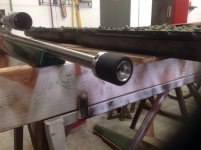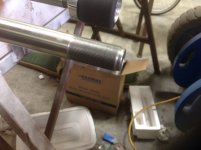With all due respect, and with the understanding that particle damping does work, if properly designed, the reference to the damping material on Jackie's and Gene's tuners as rubber bands is a cheap and inaccurate shot. Over the years I have done some experimenting with several different tuner designs, and beyond that damping. Back when the ugly convoluted rubber doughnut (otherwise known as the Sims Deresonator) hit the market, I was doing some equipment writing for Shooters News. Seeing that the only model that they offered came with an ID of 5/8" even if it was stretchy, I thought one with a larger hole in the middle would be a good move, so I called Sims and shared that thought. They must have thought that it was a good idea (and/or they already had one in the works) because soon after that, they introduces one that did, and sent me a couple of the early version to play with. About that same time, Jackie was kind enough to make me one of his tuners, which at that time were made of aluminum with no damping rubber. Thanks to a friend with a lathe, the tuner was fitted to a barrel and I did some testing of the tuner, the Deresonator and various configurations with both at the same time. What I found was that the rubber doughnut really damped barrel vibration. It was, and is very obvious. Skipping over the various combinations, what I ended up with was the tuner about two turns out from all the way on, and the doughnut immediately behind the 2" threaded section of the barrel. My impression of the combination was that that barrel shot closer to the wind (meaning that the bullet holes and the flags seemed to be more in agreement) than before, and that that very middle of the pack barrel shot better than it had before despite being on its last legs due to being alligatored in the throat. The result was that I was a beliver in tuners and some sort of damping. Coincidentally, since I did not really have the time to develop an adjustment plan, I found a good spot and left it alone, making what few adjustments that I did (about one a day)with powder charge. Little did I know that some much better shooters would settle on that approach. I was just doing the best that I could with the time and resources that I had. In any case, I do not think that Gene Buckys or Jackie Schmidt tell us about all of their experiments, and I am pretty sure that the stuff that they use in matches has survived testing and is there because it improved the performance of their respective rifles. Looking at how both have shot, I think that dismissing anything that they do might not be the best approach.



